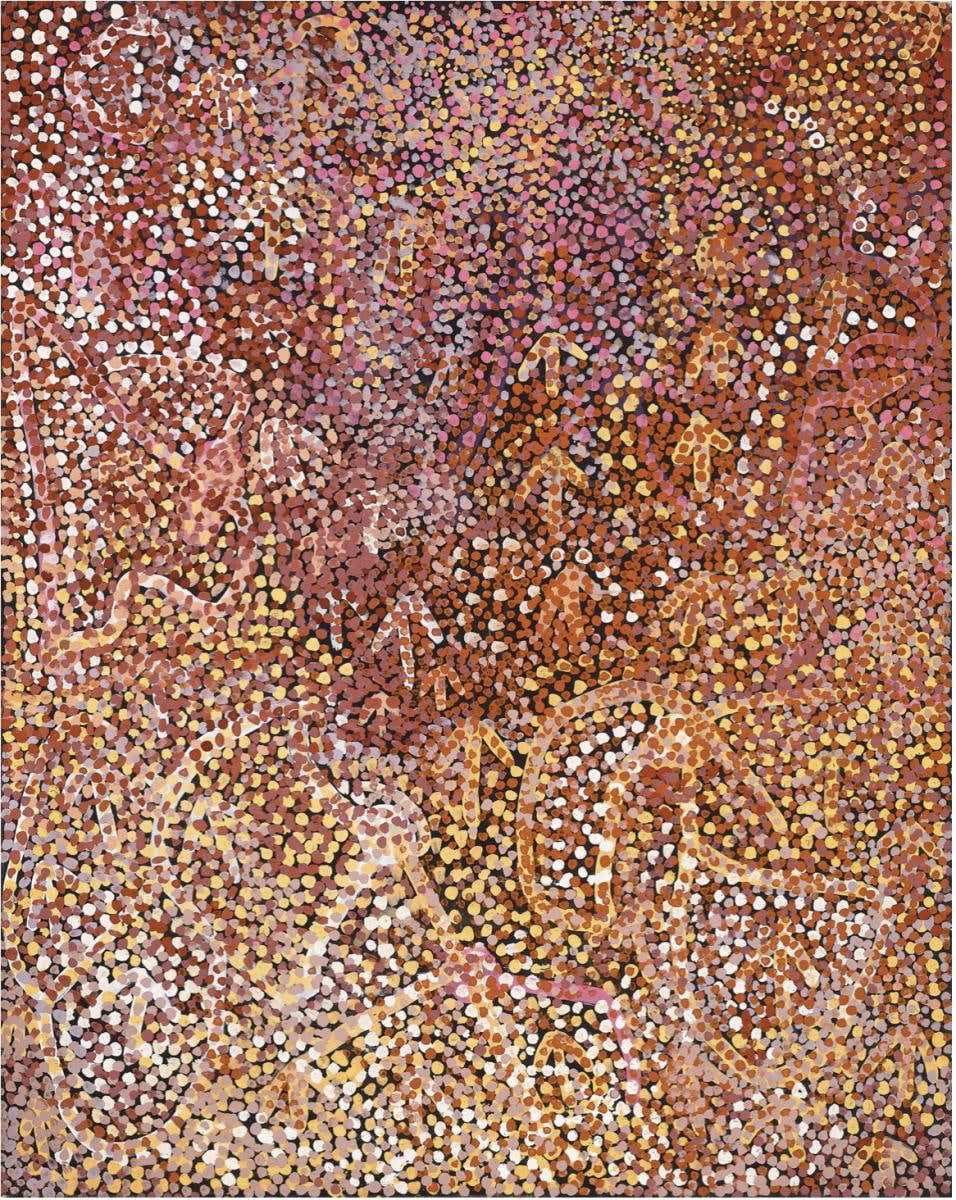
Emily Kam Kngwarray Indigenous Australian (Anmatyerr), 1910-1996
59.1 x 47.4 inch
artist’s name and Delmore Gallery cat. E013 and on label
verso: Kngwarreye, E / Alalgura – Emu Country / CS ’98
This work is accompanied by a certificate of authenticity
Recorded as E013 in the Delmore Gallery index of works, Untitled (Alalgura/Emu Dreaming) was the second of eight paintings by Emily Kngwarray produced at Delmore Downs Station in December 1989. One month later, towards the end of January 1990, the painting was consigned for sale at Coventry Gallery in Sydney.
A significant early work, Emu Dreaming, 1989, conveys the artist’s custodial responsibility for the Yam and the Emu, reflecting Kngwarray’s connection to country and Women’s ceremonies through body painting and dance. Here the tracery of grey and milky white lines signifies the meandering roots of the yam below the earth with the tracks of the traveling emu above moving between nesting sites. The underlying linear pattern is submerged by in a profusion of overlapping dots painted in a limited palette of ochres (red, yellow and white), together with soft blues and pinks. Fundamentally, this work depicts the relationship between the emu and country. Beneath the soil the bush yam is ready for digging, while above, there is a flurry of movement as the male emu moves across the landscape feeding on various seeds, simultaneously shepherding his chicks into areas where the yam thrives.
This is the country that fattens the Emu, a most highly sought source of energy and protein in traditional times. This is where the Emu Dreaming came to and travelled from. This was an important historical ceremony triggered by the nature and timing of the season provoking Emily’s memory and lasting emotions. Emily’s fantastic broad range of red, yellow and purple represents the most important custodianship, the Anooralya (finger yam) and nterkwe (bush plum).These hardy and fertile plants provide both a tuber vegetable, and a se-bearing flower called Kame (Emily’s tribal name). Other colours reflect the time of season when bush flowers flourish.
Please note that all First Nations Art is created from a so called ‘Birds Eye’ view. This means that the paintings can be hung either horizontally as well as vertically.
Provenance
Commissioned by Delmore Gallery, via Alice Springs in 1989
Coventry Gallery, Sydney, Australia
Private collection, Sydney, Australia
Hogarth Galleries, Sydney, Australia
The Laverty Collection, Sydney, Australia. Acquired from the above in September 1995
Private Collection, The Netherlands
Exhibitions
The Armory Show, SmithDavidson Gallery, New York, USA, September 2024
Art Cologne, SmithDavidson Gallery, Cologne, Germany, November 2023
Emily Kngwarreye, Coventry Gallery, Sydney, 8 May – 2 June 1990, cat. 7
Southern Reflections – Ten Contemporary Australian Artists, Art Gallery of New South Wales, Sydney, 1998
Kulturhuset (Cultural Centre), Stockholm, Sweden, 1998
Stenersen Museum, Oslo, Norway, 1999
Göteborgs Konsthall, Gothenburg, Sweden, 1999, cat. 7
Mapping Our Countries, Djamu Gallery, Australian Museum at Customs House, Sydney, 9 October 1999 – 27 February 2000
Literature
Cross, E., Southern Reflections – Ten Contemporary Australian Artists, Art Gallery of New South Wales,
Sydney, 1998, cat. 7, p. 21 (illus.)
Beyond Sacred: Australian Aboriginal Art: The Collection of Colin and Elizabeth Laverty, Hardie Grant Books, Melbourne, 2008, pp. 90 (illus.), 339
Beyond Sacred: Australian Aboriginal Art: The Collection of Colin and Elizabeth Laverty, edition II, Kleimeyer Industries Pty Ltd, Melbourne, 2011, pp. 96 (illus.), 389
